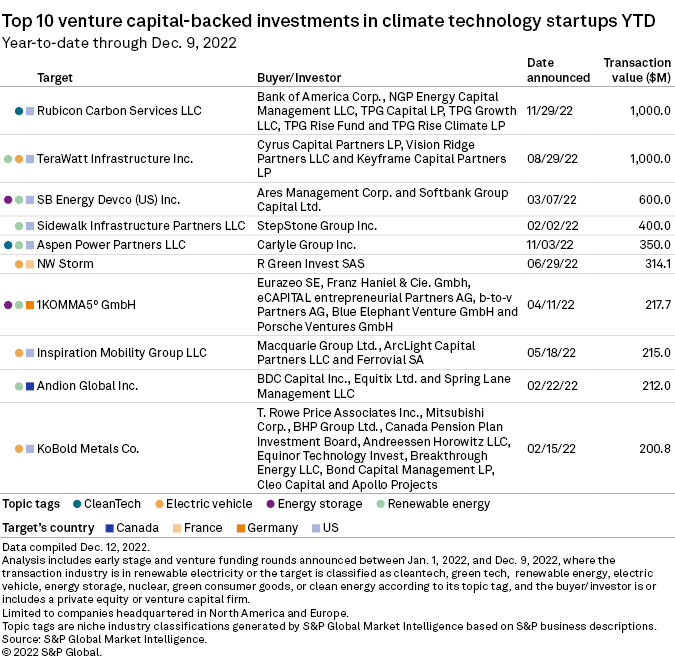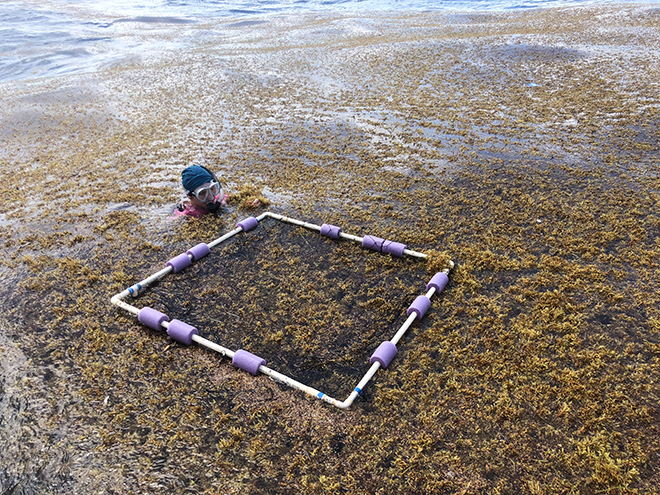Sea, space, underground: Investments in climate technology push boundaries
| Mar Fernández-Méndez, lead scientist at Seafields, measures the depth of floating sargassum at a test site in the Caribbean. Source: Seafields Solutions Ltd. |
Like the villain in the 1958 horror movie The Blob, a floating bed of algae called sargassum can double in size every two weeks, sequestering massive amounts of carbon dioxide in the process.
Control the growth of sargassum and one can control the temperature of the planet; so goes the thinking at Seafields Solutions Ltd., a U.K. startup that plans to sell carbon offsets for the project.
Seafields is about a year away from issuing a series A funding round that will enable it to build a floating seaweed farm in the South Atlantic held in place by rotating ocean currents. According to co-founder and CEO John Auckland, who comes from a background of crowdfunding and early-stage investing, courting investors has been surprisingly easy.
"I'm kind of used to doing this, and so I'm realistic about how many of those typically convert," Auckland said, referring to conversations with institutional investors. "But I've not had anyone say 'no' yet — which is mad. I've never had that. And the other thing I've never had is people finding us and asking if they can invest."
Seafields' project is one of a host of proposed climate change solutions pushing the limits of what financiers consider credible. In late 2021, Commonwealth Fusion Systems LLC raised more than $1.8 billion in venture capital to commercialize a technology to produce heat at the temperature of the sun.
In September, Commonwealth Fusion CEO Bob Mumgaard testified to Congress that he believed that the U.S. had a "real shot" at putting fusion energy on the grid by the 2030s.
And a California Institute of Technology research team is test-launching solar panels in space, supported by a $100 million gift. The goal is 24/7 renewable power, collected in space and beamed to earth wirelessly through microwaves.
The ventures, both commercial and academic, come as other climate change technologies reach technical maturity, perhaps providing other decarbonization tools.
In 2021, the majority of renewable energy resources became cheaper than fossil fuels for the first time, according to the International Renewable Energy Agency. And the Inflation Reduction Act in the U.S. is pouring billions of dollars into emerging sectors like zero-emission hydrogen and direct air capture, making those technologies more economically viable.
Despite a slowdown in venture capital deals overall, the share of that money going to decarbonization ventures has held steady since 2021. A November 2022 PwC report tracking investment in climate tech, defined as technologies "explicitly focused" on reducing emissions or mitigating their impact, found that the sector attracted more than one-quarter of all venture capital invested in 2022.

"In the face of its first real test over the past decade, climate tech markets have shown encouraging resilience," Will Jackson Moore, global ESG leader at PwC UK, said in a statement on the report. Unlike in other sectors, investor appetite for climate tech has defied headwinds, including global supply chain issues and the squeeze on energy markets caused by Russia's invasion of Ukraine.
"People are being really careful with their money, so that means they're not investing in things," Auckland said. "Most industries have been impacted. I have not seen that slight slowdown in climate investment."
In 2021, Seafields began a test to measure the decomposition rates of sargassum in the Gulf of Mexico. The end goal is an aquafarm the size of West Virginia, fed by pipes drawing up nutrients from the ocean floor and capturing CO2 through the process of photosynthesis. Once harvested, the sargassum will be collected in bales and sunk to the bottom of the ocean.
According to Auckland, Seafields is within two years of demonstrating technical proof of concept, which will enable it to start earning revenue through the sale of carbon offsets.
The startup has thus far raised $1.2 million from friends, family, angel investors and the founders' own money, Auckland said, and it is in the final stages of closing a $1.7 million seed round. The funding comes from an institutional investor dedicated to carbon dioxide removal technologies who has also pledged support in a later crowdfunding campaign.
Seafields is also in talks with investors to raise an additional $16.8 million in 2023 through a combination of equity and advanced market carbon offsets.

| A researcher collects data in one of Seafields' test trials. Source: Seafields Solutions Ltd. |
Auckland attributed the company's fundraising success to the growing threat of climate change. Unlike other decarbonization tools, such as renewable energy sources, carbon dioxide removal produces no marketable product. Meanwhile, the carbon offset market is mostly voluntary, driven by companies looking to meet their net-zero commitments.
"I think the urgency and climate anxiety is driving it," Auckland said. "A number of the investors I've spoken to want to do something about the climate crisis and feel pretty helpless."
Other innovative ventures are aimed at reducing, as opposed to removing, greenhouse gas emissions by providing alternatives to fossil fuels.
"Not to talk politically, but this really would be the democratization of energy, where in the past wars have been fought over the control and consumption and movement of oil," Andrew Van Noy, CEO of geothermal energy upstart DeepPower Inc., said in an interview.
In October, DeepPower launched with $2 million from a series A preferred seed round to develop a drilling technology for enhanced geothermal energy, also known as "superhot rock" energy.
The Utah-based company is one of several upstarts operating on the theory that geothermal energy can be tapped anywhere if one only drills deep enough. The concept involves shooting water more than 10 miles underground and bringing it back to the earth's surface to run a steam-powered turbine.
"There [are] companies that have raised a lot of money to try new methods of breaking through this very hard rock," Van Noy said. "But what's interesting is those are still unproven. So it's kind of the wild west of this exploration phase."
S&P Global Commodity Insights produces content for distribution on S&P Capital IQ Pro.








Gloss